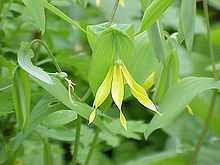Uvularia
| Bellwort merrybells | |
|---|---|
 | |
| Uvularia grandiflora | |
| Scientific classification | |
| Kingdom: | Plantae |
| (unranked): | Angiosperms |
| (unranked): | Monocots |
| Order: | Liliales |
| Family: | Colchicaceae |
| Genus: | Uvularia L. |
| Type species | |
| Uvularia perfoliata L. | |
| Synonyms[1] | |
Uvularia is a genus of plants in the family Colchicaceae, close to the lily family (Liliaceae). They are commonly called bellworts, bellflowers or merrybells. The genus name is derived from the Latin ūvula meaning "little grape," likely because of the way the flowers hang downward. For the same reason Uvularia may also refer to the similarly derived palatine uvula, which hangs down from the soft palate in the mouth. This unusual flower is found in April and May, often on wooded slopes or in ravines and it spreads by stolons,[3][4][5] or stoloniferous rhizomes.[6] The plants are usually 18 to 24 inches (45–60 cm) in height and bear one or two flowers which hang downward from the axils of the leaves.
Species
There are five species of Uvularia. All are exclusively native to North America. They grow from northern Florida to Nova Scotia west to Manitoba and south to Texas.[1][7]
- Uvularia floridana Chapm. - FL GA SC AL MS
- Uvularia grandiflora Sm. - Ontario, Québec, E + C USA
- Uvularia perfoliata L. - Ontario, E + SC USA
- Uvularia puberula Michx. EC USA
- Uvularia sessilifolia L. - E Canada, NE + SE USA, Great Lakes, Mississippi Valley
Description
They have erect, simple or twice branched stems with leaves at the top of the stems that are alternate, or perfoliated. Flowers hang downward in Spring from the top of the plants. They form singularly or sometimes in pairs.
Cultivation
These unobtrusive woodland plants are useful in the woodland and shade garden.
References
- ↑ 1.0 1.1 Search for "Uvularia", World Checklist of Selected Plant Families, Royal Botanic Gardens, Kew, retrieved 2012-12-10
- ↑ The Plant List, Oakesia conradii (Torr.) Tuck
- ↑ KAZUHIKO HAYASHI, SEIJI YOSHIDA, HIDETOSHI KATO, FREDERICK H. UTECH, DENNIS F. WHIGHAM, SHOICHI KAWANOI (1998) Molecular Systematics of the Genus Uvularia and Selected Liliales Based upon mat K and rbc L Gene Sequence Data Plant Species Biology 13 (2-3), 129–146. doi:10.1111/j.1442-1984.1998.tb00254.x
- ↑ Dennis Whigham, Anita Chapa (1999) Timing and intensity of herbivory: Its influence on the performance of clonal woodland herbs Plant Species Biology 14 (1), 29–37. doi:10.1046/j.1442-1984.1999.00004.x
- ↑ Hiroshi Kudoh, Hiroyuki Shibaike, Hideki Takasu, Dennis F. Whigham, Shoichi Kawano (1999) Genet structure and determinants of clonal structure in a temperate deciduous woodland herb, Uvularia perfoliata Journal of Ecology 87 (2), 244–257. doi:10.1046/j.1365-2745.1999.00355.x
- ↑ [Nutrient foraging in woodland herbs: a comparison of three species of Uvularia (Liliaceae) with contrasting belowground morphologies http://www.amjbot.org/cgi/content/full/88/6/1071?ck=nck] Dushyantha K. Wijesinghe and Dennis F. Whigham Smithsonian Environmental Research Center, P.O. Box 28, Edgewater, Maryland 21037 USA
- ↑ Biota of North America Program 2013 county distribution maps
External links
| Wikispecies has information related to: Uvularia |